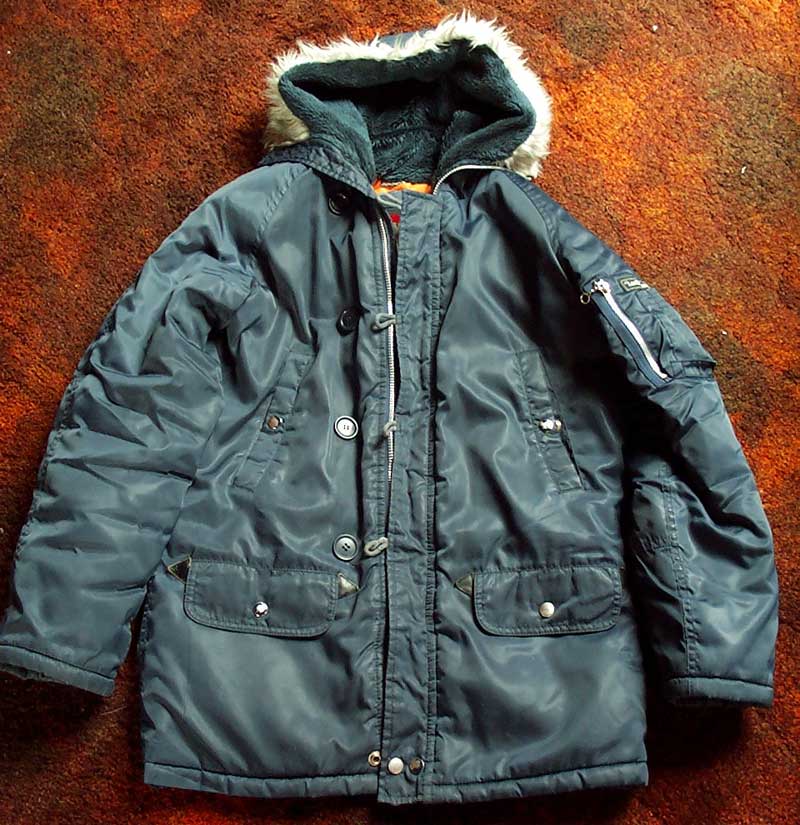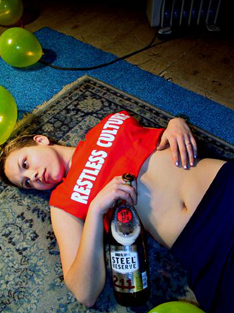|
Cagoule
A cagoule (, also spelled cagoul, kagoule or kagool), is the British English term for a lightweight weatherproof raincoat or anorak with a hood (usually without lining), which often comes in knee-length form.The Chambers Dictionary, 1994, The Canadian English equivalent is windbreaker. The word cagoule is borrowed from the French for Balaclava (clothing), balaclava or hood. In some versions, when rolled up, the hood or cross-chest front pocket doubles as a bag into which the shell can be packed. History and styles A cagoule which could be rolled up into a very compact package and carried in a bag or pocket was patented by former Royal Marine Noel Bibby and launched in the UK under the brand name Peter Storm (clothing), Peter Storm in the early 1960s.Invisible on Everest—innovation and the gear makers, Cassie Crute and Mary Rose, In 1965, the French cagoule brand K-Way was introduced. Original versions were lightweight and packable with generally an integral hood, elast ... [...More Info...] [...Related Items...] OR: [Wikipedia] [Google] [Baidu] |
Parka
A parka, like the related anorak, is a type of coat (clothing), coat with a hood (headgear), hood, that may be lining (sewing), lined with fur or fake fur. Parkas and anoraks are staples of Inuit clothing, traditionally made from Reindeer, caribou or pinniped, seal skin, for hunting and kayaking in the frigid Arctic. Some Inuit anoraks require regular coating with fish oil to retain their water resistance. Parkas are typically longer, often extending to the thighs or knees. Anoraks are usually shorter than parkas, often hip-length, and are traditionally a pull-over jacket. The words ''anorak'' and ''parka'' have been used interchangeably, but they are somewhat different garments. Strictly speaking, an anorak is a waterproof, hooded, pull-over jacket without a front opening, and sometimes drawstrings at the waist and cuffs, and a parka is a hip-length cold-weather coat, typically stuffed with down feather, down or very warm synthetic fiber, and with a fur-lined hood. Etymology T ... [...More Info...] [...Related Items...] OR: [Wikipedia] [Google] [Baidu] |
Raincoat
A raincoat is a waterproof or water-resistant garment worn on the upper body to shield the wearer from rain. The term rain jacket is sometimes used to refer to raincoats with long sleeves that are waist-length. A rain jacket may be combined with a pair of rain pants to make a rainsuit. Rain clothing may also be in one piece, like a boilersuit. Raincoats, like rain ponchos, offer the wearer hands-free protection from the rain and elements; unlike the umbrella. Modern raincoats are often constructed from waterproof fabrics that are breathable, such as Gore-Tex or Tyvek and DWR-coated nylon. These fabrics and membranes allow water vapor to pass through, allowing the garment to 'breathe' so that the sweat of the wearer can escape. The amount of pouring rain a raincoat can handle is sometimes measured in the unit millimeters, water gauge. Early history One of oldest examples of rainwear recorded is likely the woven grass cape/mat of Ötzi, around 3230 BCE. The Olmec Native Ame ... [...More Info...] [...Related Items...] OR: [Wikipedia] [Google] [Baidu] |
Anorak
A parka, like the related anorak, is a type of coat with a hood, that may be lined with fur or fake fur. Parkas and anoraks are staples of Inuit clothing, traditionally made from caribou or seal skin, for hunting and kayaking in the frigid Arctic. Some Inuit anoraks require regular coating with fish oil to retain their water resistance. Parkas are typically longer, often extending to the thighs or knees. Anoraks are usually shorter than parkas, often hip-length, and are traditionally a pull-over jacket. The words ''anorak'' and ''parka'' have been used interchangeably, but they are somewhat different garments. Strictly speaking, an anorak is a waterproof, hooded, pull-over jacket without a front opening, and sometimes drawstrings at the waist and cuffs, and a parka is a hip-length cold-weather coat, typically stuffed with down or very warm synthetic fiber, and with a fur-lined hood. Etymology The word ''anorak'' comes from the Greenlandic (''Kalaallisut'') word ''annoraaq ... [...More Info...] [...Related Items...] OR: [Wikipedia] [Google] [Baidu] |
Windbreaker
A windbreaker, or a windcheater, is a thin fabric jacket designed to resist wind chill and light rain, making it a lighter version of the jacket. It is usually lightweight in construction and characteristically made of synthetic fiber, synthetic material. A windbreaker often incorporates an elastic waistband, elastic armbands and a zipper to allow adjustment for weather conditions. Regular jackets or coats may include a type of windbreaker as an interlining that can be removed when desired. Windbreakers sometimes include a hood that may be removable and/or stowable. Many windbreakers may also include large pockets on the inside or the outside which allow belongings to be protected from the weather. Windbreakers may offer light to moderate Thermal insulation, insulating protection, more so than a sweater, but less than an overcoat. Windbreakers are primarily worn during the Summer, warmer seasons when wind or rain are expected, or as part of a Layering (clothing), layering stra ... [...More Info...] [...Related Items...] OR: [Wikipedia] [Google] [Baidu] |
Peter Storm (clothing)
Peter Storm is an outdoor clothing brand developed in the United Kingdom. It was originally created in 1954 by former Royal Marine Noel Bibby as a company supplying waterproof nylon rainwear. Bibby was credited with inventing the Cagoule (raincoat), cagoule. After Bibby's death in 1989, the British rights to the name were bought by Blacks Leisure Group, subsequently acquired by JD Sports, and Peter Storm branded clothes are now sold mainly through its chains of Blacks Outdoor Retail, Blacks, Millets, Tiso and GO Outdoors shops. A different line of clothing is sold internationally under the Peter Storm name by Outdoor Equipment. References External links International line website Clothing companies of the United Kingdom British brands Outdoor clothing brands {{UK-company-stub ... [...More Info...] [...Related Items...] OR: [Wikipedia] [Google] [Baidu] |
Peter Storm Vintage Cagoule Front
Peter may refer to: People * List of people named Peter, a list of people and fictional characters with the given name * Peter (given name) ** Saint Peter (died 60s), apostle of Jesus, leader of the early Christian Church * Peter (surname), a surname (including a list of people with the name) Culture * Peter (actor) (born 1952), stage name Shinnosuke Ikehata, a Japanese dancer and actor * ''Peter'' (1934 film), a film directed by Henry Koster * ''Peter'' (2021 film), a Marathi language film * "Peter" (''Fringe'' episode), an episode of the television series ''Fringe'' * ''Peter'' (novel), a 1908 book by Francis Hopkinson Smith * "Peter" (short story), an 1892 short story by Willa Cather * ''Peter'' (album), a 1972 album by Peter Yarrow * ''Peter'', a 1993 EP by Canadian band Eric's Trip * "Peter", 2024 song by Taylor Swift from '' The Tortured Poets Department: The Anthology'' Animals * Peter (Lord's cat), cat at Lord's Cricket Ground in London * Peter (chief mouser), Ch ... [...More Info...] [...Related Items...] OR: [Wikipedia] [Google] [Baidu] |
1990s Fashion
Fashion in the 1990s was defined by a return to minimalism, minimalist fashion, in contrast to the more elaborate and flashy 1980s in fashion, trends of the 1980s. One notable shift was the mainstream adoption of tattoos, body piercings aside from ear piercing and, to a much lesser extent, other forms of body modification such as Human branding, branding. In the early 1990s, several late 1980s fashions remained very stylish among men and women. However, the popularity of grunge and alternative rock music helped bring the simple, unkempt grunge look to the mainstream by that period. This approach to fashion led to the popularization of the casual chic look, which included T-shirts, jeans, hoodies, and sneakers, a trend which would continue into the 2000s. Additionally, fashion trends throughout the decade recycled styles from previous decades, most notably the 1950s, 1960s and 1970s. Unlike the 1980s, when fashion with volume was commonplace, the 1990s was more characterized as ti ... [...More Info...] [...Related Items...] OR: [Wikipedia] [Google] [Baidu] |
1980s Fashion
Fashion of the 1980s was characterized by a rejection of psychedelic colored, ornate fashions of the 1970s fashion, 1970s. Punk fashion began as a reaction against both the hippie movement of the past decades and the materialist values of the current decade. The first half of the decade was relatively tame in comparison to the second half, which was when apparel became very bright and vivid in appearance. One of the features of fashion in the second half of the 1980s was the interest in alternative forms. In the 1980s, Alternative fashion, alternative trends became widespread. This phenomenon has been associated with such phenomena as street style, Punk rock, punk and post-punk. During the 1980s, Shoulder pad (fashion), shoulder pads, which also inspired "power dressing," became common among the growing number of career-driven women. Hair in the 1980s was typically big, curly hair, curly, bouffant and heavily styled. Television shows such as ''Dynasty (1981 TV series), Dynasty'' ... [...More Info...] [...Related Items...] OR: [Wikipedia] [Google] [Baidu] |
1970s Fashion
Fashion in the 1970s was about individuality. In the early 1970s, ''Vogue'' proclaimed "There are no rules in the fashion game now" due to overproduction flooding the market with cheap synthetic clothing. Common items included mini skirts, bell-bottoms popularized by hippies, vintage clothing from the 1950s and earlier, and the androgynous glam rock and disco styles that introduced platform shoes, bright colors, glitter, and satin. New technologies brought about advances such as mass production, higher efficiency, generating higher standards and uniformity. Generally the most famous silhouette of the mid and late 1970s for both genders was that of tight on top and loose at the bottom. The 1970s also saw the birth of the indifferent, anti-conformist casual chic approach to fashion, which consisted of sweaters, T-shirts, jeans and sneakers. One notable fashion designer to emerge into the spotlight during this time was Diane von Fürstenberg, who popularized, among other thing ... [...More Info...] [...Related Items...] OR: [Wikipedia] [Google] [Baidu] |
1960s Fashion
Fashion of the 1960s featured a number of diverse trends, as part of a decade that broke many fashion traditions, adopted new cultures, and launched a new age of social movements. Around the middle of the decade, fashions arising from small pockets of young people in a few urban centers received large amounts of media publicity and began to heavily influence both the ''haute couture'' of elite designers and the mass-market manufacturers. Examples include the mini skirt, miniskirt, culottes, go-go boots, and more experimental fashions, less often seen on the street, such as curved Polyvinyl chloride, PVC dresses and other PVC clothing, PVC clothes. Mary Quant popularized the mini skirt, miniskirt, and Jackie Kennedy introduced the pillbox hat; both became extremely popular. False eyelashes were worn by women throughout the 1960s. Hairstyles were a variety of lengths and styles. Psychedelic prints, neon colors, and mismatched patterns were in style. In the early to mid-1960s, Lo ... [...More Info...] [...Related Items...] OR: [Wikipedia] [Google] [Baidu] |
Jackets
A jacket is a garment for the upper body, usually extending below the hips. A jacket typically has sleeves and fastens in the front or slightly on the side. Jackets without sleeves are vests. A jacket is generally lighter, tighter-fitting, and less insulating than a coat (clothing), coat, but both are outerwear. Some jackets are fashionable, while some others serve as protective clothing. Etymology The word ''jacket'' comes from the French word ''jaquette''. The term comes from the Middle French noun ''jaquet'', which refers to a small or lightweight tunic. In Modern French, ''jaquette'' is synonymous with ''jacket''. Speakers of American English sometimes informally use the words ''jacket'' and ''coat'' interchangeably. The word is cognate with Spanish language, Spanish ''jaco'' and Italian language, Italian ''giacca'' or ''giacchetta'', first recorded around 1350s. It is ultimately loaned from Arabic ''shakk (شكّ)'', which in turn loaned from Aramaic language, Aramaic and He ... [...More Info...] [...Related Items...] OR: [Wikipedia] [Google] [Baidu] |
Rain Poncho
A poncho (; ; ; "blanket", "woolen fabric") is a kind of plainly formed, loose outer garment originating in the Americas, traditionally and still usually made of fabric, and designed to keep the body warm. Ponchos have been used by the Native American peoples of the Andes, Patagonia, and the Valley of Mexico since pre-Hispanic times, in places now under the territory of Argentina, Bolivia, Brazil, Chile, Colombia, Ecuador, Mexico, Peru, Uruguay, and Venezuela, and have also become familiar in parts of the U.S. A rain poncho is made from a watertight material designed to keep the body dry from the rain. Types In its simplest form, the poncho is essentially a single large sheet of fabric with an opening in the center for the head. It often has an extra piece of fabric serving as a hood. Rainproof ponchos are normally fitted with fasteners to close the sides once the poncho is draped over the body, with openings provided for the arms. Many ponchos have hoods attached to ward o ... [...More Info...] [...Related Items...] OR: [Wikipedia] [Google] [Baidu] |








